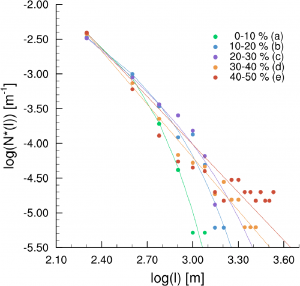This is an old revision of the document!
Table of Contents
Cloud geometry
The earth´s radiation budget is heavily influenced by the variability in cloud cover 1). In addition, individual clouds (in particular cumulus) can be very irregular, associated with inefficient vertical overlap. It is therefore essential to understand the geometry and spatial structure of shallow cumulus (Scu) cloud fields to be able to simulate the radiative fluxes adequately. Reliable cloud population information in terms of size is also necessary for the scale-aware parameterization schemes for convection that are currently being developed to address the grey zone problem.
3D cloud reconstructions using stereo cameras
The SOCLES project (Stereo Observations of Clouds for LES Validation and Sub-scale Cloud Parameterizations, https://gepris.dfg.de/gepris/projekt/430226822) combines high-frequency cloud observations by multiple hemispheric cameras with high-resolution Large-Eddy Simulations (LES) at a mid-latitude continental meteorological site JOYCE. The science objective is to better understand and quantify fine-scale spatial and temporal structures of shallow cumulus cloud populations. These cloud fields are highly heterogeneous and quickly evolve on a broad range of spatial scales. This behavior has complicated their representation in numerical weather prediction and climate models. The project will fill the information gap related to fine-scale cloud structures that has hampered progress in cumulus parameterization. This problem has become more urgent with ongoing developments in supercomputing, allowing for ever higher resolutions at which the conceptual basis of classic cumulus parameterizations is no longer valid. We approach this problem by exploiting the synergy between LES and stereo camera observations. The high-resolution sampling capability of stereo reconstruction in four dimensions and its considerable spatial coverage will allow us to capture cumulus cloud populations in unprecedented detail, which cannot be achieved with vertically pointing instrumentation or satellite sensors.
The LES realizations supplement the observational data, but also allow for the testing of measurement strategies, for example concerning the required density of the stereo camera network. Testing the realism of the LES is a first step and a major research objective, involving determination of the resolution at which simulated cloud irregularity starts to match the stereo camera observations. To this purpose we make use of Blender and its ray-tracing engine. This allows realistic rendering of three-dimensional cloud fields from LES, including optical effects such as absorption, scattering, sun glare and haze effects. Hemispheric blender projections are also used as a camera instrument simulator for LES, exactly mimicking the way visual instruments like Total Sky Imagers (TSI) view the world. This allows a fair comparison between model and measurements. An example hemispheric Blender movie of simulated clouds over JOYCE is shown above.
Size statistics of shallow cumulus
This project is looking into detail into the spatial buildup of cumulus cloud populations, and how best to describe them. Patterns in cloud fields are studied by means of cloud size distributions and nearest neighbour spacing. The shape of the cloud size distribution gives information about the clustering and merging in the cloud field and is important for the EDMF scheme. The organization in a cloud population can also be defined by the distances between the clouds, or the nearest neighbour spacing.
In a recent study by Van Laar et al (2019), a total of 146 Scu days are simulated using DALES, which provides a broad parameter space and the possibility to compute cloud size statistics. Some first results show that the shape of the cloud size distribution greatly depends on the cloud fraction and the same is the case for the maximum cloud size in the domain (Fig. 1). Previous research points to a correlation between cloud size and spacing, this is the next thing that will be investigated.
Figure 1 – Cloud size distributions for five different days with all a different cloud fraction. The distribution is described by a power law–exponential function.
In a follow-up study by Van Laar and Neggers (2021), we investigated cloud spacing in superlarge ICON-LEM simulations of subtropical marine cumulus clouds fields in the Caribbean as observed during NARVAL. These simulations were generated as part of the HD(CP)2 project. More specifically, we studied how nearest neighbor spacing depends on cloud size, exploring both classic and new definitions of the spacing. We find that spacing between clouds of any size behaves logarithmically, while spacing between clouds of equal size follows an exponential size-dependence. The exponential dependence reflects the increasing role of mesoscale circulations associated with the largest clusters in the cloud field.
Figure 2 – MODIS true color image of the cloud field during NARVAL.
Figure 3 – Cloud size distributions derived from MODIS (left) and ICON-LEM (right)
Figure 4 – Logarithmic and exponential dependence on cloud size in the Nearest Neighbor Spacing (NNS) between clouds of any size (top) and clouds of equal size (bottom)


